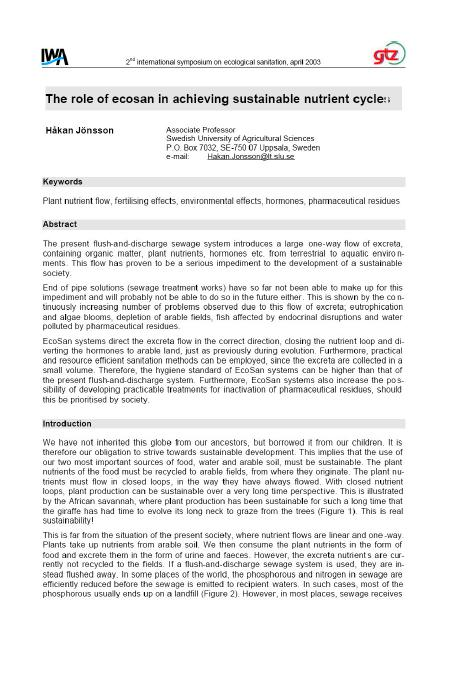
Published in: 2003
Author:
Jönsson, H.
Uploaded by:
SuSanA secretariat
Partner profile:
common upload
4095 Views
32 Downloads
Content - Summary
The present flush-and-discharge sewage system introduces a large one-way flow of excreta, containing organic matter, plant nutrients, hormones etc. from terrestrial to aquatic environments. This flow has proven to be a serious impediment to the development of a sustainable society.
End of pipe solutions (sewage treatment works) have so far not been able to make up for this impediment and will probably not be able to do so in the future either. This is shown by the continuously increasing number of problems observed due to this flow of excreta; eutrophication and algae blooms, depletion of arable fields, fish affected by endocrinal disruptions and water polluted by pharmaceutical residues.
EcoSan systems direct the excreta flow in the correct direction, closing the nutrient loop and diverting the hormones to arable land, just as previously during evolution. Furthermore, practical and resource efficient sanitation methods can be employed, since the excreta are collected in a small volume. Therefore, the hygiene standard of EcoSan systems can be higher that that of the present flush-and-discharge system. Furthermore, EcoSan systems also increase the possibility of developing practicable treatments for inactivation of pharmaceutical residues, should this be prioritised by society.
Additional information
Paper Presented in the "2nd International Symposium on Ecological Sanitation", April 2003, IWA and GTZ
Bibliographic information
Jönsson, H. (2003). The role of ecosan in achieving sustainable nutrient cycles.
Filter tags
English Faeces or faecal sludge Fertiliser Urine Urine diversion dehydration toilets (UDDTs)














